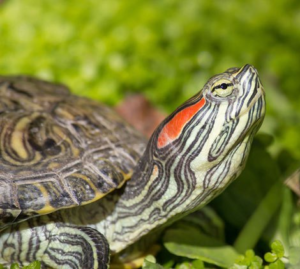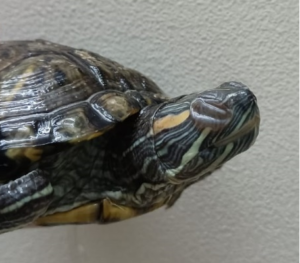HYPOVITAMINOSIS A AND SWOLLEN EYELIDS IN TURTLES
Vivek Kumar Maurya1, Shivani Bante2, Jagmohan Rajput1, Anushka Gupta3, Akanksha Pandey4
Vitamin A deficiency is encountered most commonly in young, aquatic turtles. Rapid growth during feeding of unsupplemented meat, insects, lettuce, or poorly formulated commercial pellets is the primary risk factor in captive species. Chelonians may be carnivorous, herbivorous or omnivorous in feeding habits. Aquatic turtles are chiefly carnivorous reptiles feeding on snails, fish, mice, slugs, worms and insects. Lettuce or other plant material is occasionally given to captive aquatic turtles. The captive diet is also supplemented with liver oil or vitamins containing A, D and E.
In free-ranging tortoises such as the eastern box turtle (Terrapene carolina carolina), exposure to organochlorines may play a role by depletion and alteration of vitamin A metabolism. Affected animals undergo squamous metaplasia of their orbital glands and ducts, leading to blockage of their ducts by desquamated cells. Sequelae include a clinically significant increase in the size of the glands, blepharoedema, and blepharoconjunctivitis. This often leads to closure of the eyelids, predisposing patients to secondary bacterial keratitis and conjunctivitis. In addition, there is a possibility that vitamin A deficiency may lead to aural abscesses in some species, though further study is warranted.
Patients often exhibit poor growth and a decrease in appetite. If allowed to progress, squamous metaplasia of the respiratory, gastrointestinal, renal, and pancreatic epithelia can lead to death. Diagnosis is often presumptive, based upon a detailed history, evaluation of the animal’s husbandry, and response to vitamin A supplementation. Conjunctival swabs for cytology and culture are useful to rule out a secondary infection. In patients who are non-responsive to treatment, biopsy of the eyelid and conjunctiva may be necessary to rule out other causes of blepharitis or neoplasia.


Fig. 1. Normal eyes in a Red-eared Slider Fig. 2. Blepharitis as a result of hypovitaminosis A
| Parenteral Vitamin A dosages in turtles | |
| Species | Recommended dose |
| Aquatic turtles | 200-300 IU/kg weekly. Starting dose: 50-50000 IU/turtle |
| Box turtles | 1000-2000 IU/kg weekly x 2-6 doses |
| Red-eared sliders | 5000-10000 IU/kg PO |
Successful treatment requires acute vitamin A supplementation, correction of long-term diet and husbandry deficiencies, supportive care, and elimination of secondary infections. Early in the disease, when patients are still willing to eat, dietary change is often effective. For herbivorous species, vegetation high in beta-carotene (dark, leafy greens, carrots, squash, sweet potatoes, and yellow bell peppers) should be included in a balanced diet. Omnivorous aquatic species may be fed commercial trout pellets supplemented with cod liver oil. When a more advanced disease is present, weekly parenteral injections of vitamin A are necessary. When administering injectable Vitamin A, avoiding overdosage is of extreme importance. Overdosage (approximately 100x the recommended intake) results in sloughing of the skin around the neck and forelimbs of turtles, anorexia, and mortality. Concurrent treatment with topical antibiotic ointment is recommended to treat secondary bacterial keratoconjunctivitis. Abscesses, when present, often require surgical removal. This must be performed with care to preserve functional eyelid margins. Additionally, most turtles with vitamin A deficiency are also deficient in other nutrients. The full diet should be reviewed to ensure adequate sources of vitamin E, zinc, and protein.


